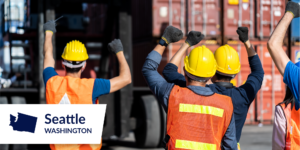
February 2022 was the fourth month of a major strike of concrete supply workers in King County, Washington, home to the Seattle metropolitan area — and construction projects around the county are feeling the impact significantly.
330 truck drivers, concrete pourers, mechanics, technicians, and yard workers have gone on strike across the county, asking for competitive wage increases and better health care while claiming that their employers are not negotiating in good faith.
“[Lead negotiator Charlie Oliver] seems to believe these workers exist solely for him to exploit and abuse, and that they can be replaced at a moment’s notice,” said Teamsters Local 174 Secretary-Treasurer Rick Hicks about the negotiating process. “Well, now is his chance to prove it, or he can come back to the bargaining table with a legitimate offer rather than more insults.”
The strike includes workers from Gary Merlino Construction, Stoneway Concrete, Cadman, CalPortland, Salmon Bay Sand & Gravel, and Lehigh Cement — the six largest concrete suppliers in the area.
Unsurprisingly, the strike has had significant effects on construction throughout the greater Seattle area, with many projects slowed and other jobs affected.
Some area contractors have estimated that the strike could cause project delays of up to four months depending on the length of the dispute, as laid-off workers will need to be rehired and the concrete market will need to return to normal levels.
“We’re kind of sitting dead in the water right now on two projects,” said Rob Warnaca, president of Kirkland, Washington’s GenCap Construction. The company says it has two apartment building constructions in the Seattle area which are in the “concrete phase” during which workers would normally be pouring foundation and other concrete components — a process that is completely held up due to the strike.
This has also been an issue for major, high-publicity projects like the expansion of the Washington State Convention Center in downtown Seattle.
“The contractor was able to work around it for some period of time, but after a while you can’t keep working around concrete when a building has a whole bunch of concrete,” said Matt Griffin, managing partner at Pine Street Group.
It’s already had a tangible effect on the convention center — though the expansion was originally slated to open in mid-2022, a February 2 announcement noted that the concrete strike would push the project’s opening back until at least January 2023.
Other contractors have been rendered completely unable to get work going, with a direct result coming down on construction workers.
Leon Johnson, president of Mill Creek, Washington’s Greater Seattle Concrete Company, said he had to lay off 90 out of his 170 employees in the last few weeks of December due to the effects of the strike.
“Laying off people…before Christmas was not [a] cool thing to do,” he noted. “[But] as an employer, my hands are tied…If we cannot get concrete, then there is not work to perform.”
Seattle’s Sound Transit transportation agency is also seeing setbacks on its projects.
Both Sound Transit and the Washington State Department of Transportation have been publicly wary of the effects of the strike, saying that “a prolonged work stoppage could delay critical regional infrastructure activities under construction currently, including roads, bridges, girders, light rail guideways, and much more.”
Sound Transit noted that even when the strike does come to an end, “high demand may delay concrete availability.”
This hasn’t been the only major Seattle-area strike in the past months, either — 2,000 members of the Northwest Carpenter Union struck for over three weeks in September and October 2021 following a breakdown in negotiations with Associated General Contractors.